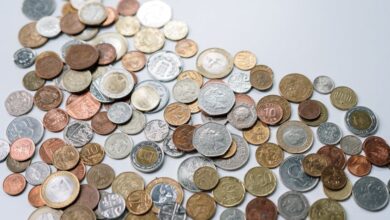Metals in Motion: Exploring Industrial Demand and Investment Trends in a Changing Economy

In an ever-evolving global economy, the interplay between metals and market dynamics is more significant than ever. As industries pivot towards sustainability and investors seek reliable assets amidst economic uncertainty, the role of metals—both precious and industrial—takes center stage. This article delves into the multifaceted world of metal markets, beginning with silver, whose dual role as both an industrial commodity and a sought-after investment reflects its unique position in today’s economy. We will explore how copper prices serve as a barometer for global economic health, the rising demand for rare earth metals driven by green energy technologies, and the ongoing debate between platinum and palladium as investment choices. Additionally, we will examine how strategic diversification into metals can bolster investment portfolios, the influence of inflation on metal prices, the future of aluminum in sustainable practices, and the effect of mining regulations on market values. Join us as we navigate these critical discussions, shedding light on the vital role metals play in shaping our economic landscape.
- 1. Silver's Dual Role: Navigating Industrial Usage and Investment Appeal
- 2. Copper Prices as Economic Barometers: Understanding Their Global Significance
- 3. The Green Revolution: Rare Earth Metals and the Shift Towards Sustainable Energy
1. Silver's Dual Role: Navigating Industrial Usage and Investment Appeal
Silver's unique position in both industrial applications and investment markets underscores its significance in the global economy. On one hand, silver is a critical component in various industrial processes, particularly in electronics, photovoltaics, and medical applications. Its high electrical conductivity and antimicrobial properties make it indispensable in the manufacturing of circuit boards, solar panels, and medical devices. As industries increasingly pivot towards sustainable technologies, the demand for silver in renewable energy sectors, especially solar power, is expected to grow substantially.
On the other hand, silver holds a prominent place in the investment landscape. Often viewed as a safe-haven asset, it provides investors with a hedge against inflation and economic uncertainty. Historical trends indicate that during times of market volatility or currency devaluation, silver tends to retain its value, attracting both individual and institutional investors. Furthermore, the relatively lower price of silver compared to gold makes it an appealing option for those looking to diversify their investment portfolios without significant capital outlay.
The interplay between silver's industrial demand and its investment appeal creates a dynamic market environment. Changes in technology or shifts in economic conditions can lead to fluctuations in silver prices, as increased industrial usage might strain supply, thereby enhancing its investment value. Conversely, an economic downturn may diminish industrial demand but could simultaneously elevate silver's status as a safe-haven asset. Understanding this dual role is crucial for investors and industry stakeholders alike, as it highlights the multifaceted nature of silver in navigating the complexities of the global market.
2. Copper Prices as Economic Barometers: Understanding Their Global Significance
Copper prices are often viewed as a critical indicator of global economic health, reflecting the dynamics of supply and demand across various sectors. As a key component in construction, electrical wiring, and manufacturing, copper's extensive applications make it highly sensitive to economic activity. When economic growth is robust, the demand for copper typically rises, driving up prices. Conversely, during periods of economic downturn, reduced construction and manufacturing activity can lead to lower demand and declining prices.
Several factors contribute to copper's status as an economic barometer. First, its use in infrastructure development—particularly in emerging markets—means that copper prices can signal changes in investment trends. For instance, an increase in copper prices may suggest that countries are ramping up construction projects, indicating optimism about future growth. Conversely, a decline in prices could indicate economic slowdowns or decreased industrial activity.
Additionally, copper prices are influenced by global trade dynamics. Tariffs, trade agreements, and geopolitical tensions can disrupt supply chains, affecting availability and pricing. For example, significant trade disputes can lead to uncertainty, impacting investor sentiment and the overall market.
Moreover, the rise of renewable energy technologies, which rely heavily on copper for components like solar panels and wind turbines, adds another layer to its significance. As the world increasingly shifts toward sustainable energy solutions, the demand for copper is likely to grow, suggesting that fluctuations in its price will continue to be closely monitored as indicators of both traditional and emerging economic trends.
In summary, copper prices serve as a vital economic barometer, reflecting not only the state of the industrial sector but also broader global economic conditions. Investors and policymakers alike closely watch these price movements to gauge economic health and make informed decisions.
3. The Green Revolution: Rare Earth Metals and the Shift Towards Sustainable Energy
The transition to sustainable energy has ushered in a renewed focus on rare earth metals, which are critical components in various green technologies. These metals, including neodymium, dysprosium, and terbium, play vital roles in manufacturing powerful magnets for wind turbines, efficient batteries for electric vehicles, and advanced electronics. As demand for renewable energy sources grows, so does the need for these materials, fundamentally reshaping market dynamics.
The increasing deployment of renewable energy systems is directly correlated with rising demand for rare earth metals. For instance, electric vehicles (EVs) require substantial amounts of rare earth elements for their motors and batteries, contributing to a significant uptick in global consumption. Additionally, the production of energy-efficient devices, such as LED lights and high-capacity batteries, further amplifies this demand. As countries strive to meet ambitious climate targets, the reliance on rare earth metals is expected to intensify.
However, the supply chain for these materials poses challenges. Rare earth metals are predominantly mined in a few countries, with China being the largest producer. This concentration raises concerns about supply security and geopolitical risks, prompting nations to explore alternative sources and recycling methods. The development of new mining projects and the enhancement of recycling technologies are essential to ensure a stable supply, thereby supporting the green revolution.
In conclusion, the shift towards sustainable energy has positioned rare earth metals as crucial players in the global market. As technology continues to evolve and the need for cleaner energy increases, their significance will likely grow, shaping both industrial practices and investment strategies in the years to come.
In conclusion, the intricate interplay between metals and the global economy underscores their significance in both industrial applications and investment landscapes. Silver’s unique position as both a crucial industrial component and a sought-after investment asset highlights its versatility and enduring value. Similarly, copper prices serve as a vital indicator of economic health, reflecting broader trends in global demand and supply dynamics. The rise of green energy technologies has intensified the demand for rare earth metals, making them essential for a sustainable future.
When comparing platinum and palladium, investors must weigh factors such as market demand, industrial usage, and investment potential to make informed decisions. Additionally, metals play a critical role in diversifying investment portfolios, providing a hedge against economic uncertainty, particularly in times of inflation, which directly impacts the pricing dynamics of precious and industrial metals alike.
As we look ahead, aluminum's prospects in a sustainable economy appear promising, while the influence of mining regulations continues to shape market prices and investment strategies. Collectively, these insights equip investors and industry stakeholders with a deeper understanding of the metal markets, guiding them towards informed decisions in a rapidly evolving economic landscape. Ultimately, recognizing the multifaceted roles of these metals will be key to navigating the challenges and opportunities that lie ahead.





